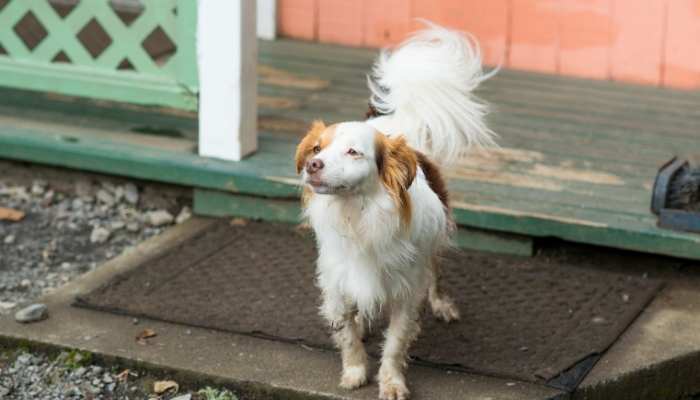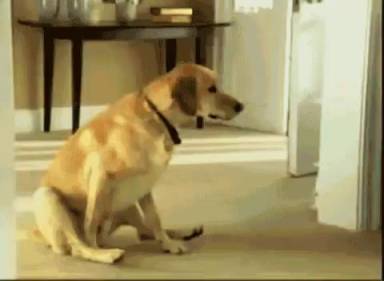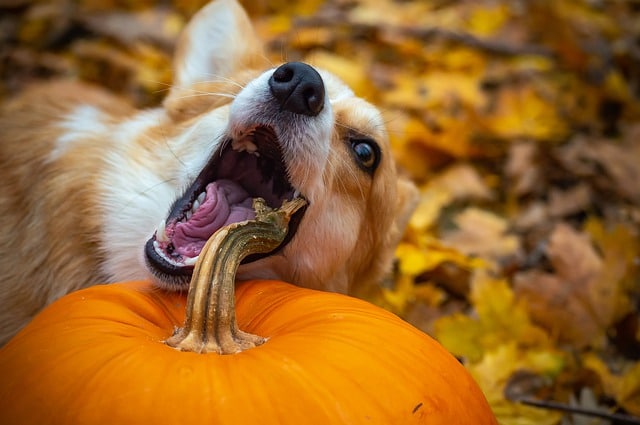Have you fallen in love with a three-legged dog at the shelter or pet adoption facility? Or maybe your dog’s facing a leg amputation due to cancer or a serious injury. It’s hard to consider what life will be like for a dog and if you’ll be able to adapt to a three-legged fur baby!
Connect with a verified veterinarian in minutes. Licensed vets are available 24/7 to answer your questions. No need to worry about your furry family member.
We’re here to tell you three-legged dogs deserve love, happiness and a fur-ever home just like any regular dog with four legs. We’ve put together some information that we hope will take the mystery out of having a dog with three legs and that dogs really can be quite happy on three legs!
Our Experience Taking Care of A Three-Legged Dog
Before we move into the information about life with a three-legged dog, we’d like to share our own experience of living with a dog who had only three legs. Years ago, we had a beautiful silver toy poodle, whose name was Pepe. He looked like a lamb and had such a loving personality! He was a special little guy who seemed to be loved by everyone who saw him. He was pretty healthy, until one year he developed cancer in his front left paw. The vet tried to remove the cancer but didn’t catch it all. Eventually the cancer returned and started to affect Pepe’s leg and his ability walk. We had to make the heart-rending decision to have his entire leg amputated.
The vet performed the surgery, and everything went well. Once Pepe was home, he made an astonishingly quick recovery! After a few weeks, Pepe was back to his normal, loving and cute self—just minus one leg. He’d always been a fast runner, but we really didn’t think he’d be able to run again after the loss of his front leg. However, he soon proved us wrong. One day, while playing outside in the backyard, Pepe just all of a sudden started running like the wind! You should have seen him look like a silver flash running across the backyard! It was amazing! We were all very happy to see Pepe regain his zest for life and running. From that time on, Pepe was always on the go—running on three legs. We lovingly started calling him “Tri Pod,” which he really seemed to enjoy.
Pepe proved to us that a dog with three legs is much like any other dog. Once they start to recover and learn to maneuver in their new three-legged state, they will run, play and do almost everything their 4-legged companions can do!
How to Care for a Three Legged Dog
Dogs with three legs are still dogs and love to be dogs. So, when it comes to caring for a dog with three legs, be ready to treat him like any normal dog. He’ll love you for it! When dogs have their legs amputated, they’re able to recover after a few weeks—usually about two months is the normal healing time. After this, a dog will learn to be happy and get around on three legs. In fact, dogs are able to adapt to the loss of a leg much easier than their pet parents.
The main issue will be keeping your dog healthy and happy. You’ll have to make sure they eat the best quality food you can provide, get enough exercise to keep them fit, etc. In fact, dogs will want to be active again—and be back to enjoying their lives. Walking is always a great way to give your tri-pod exercise. With walks, you may need to keep them short in the beginning. But as he recovers, you may find that he’s able to walk longer periods. Let your dog be the guide as to how far and how long to go. You’ll quickly notice if he begins feeling any discomfort.
Another idea is swimming and other water activities, where the loss of a limb won’t affect his enjoyment of the workout. Watch out for fatigue when exercising your fur baby. He may slow down, pant or take frequent breaks. These are all signs it’s time to go home and let him enjoy a good rest. You don’t want him to overdo his activities.

Review symptoms, medications & behavior to keep your pets healthy with a Vet Online in just minutes.
Ask a Vet Live Now3 Legged Dog Harness
Some dogs need a little more assistance after they lose a limb. For these dogs, it might be helpful to get a dog harness especially made for three-legged dogs. Here are some of the best harnesses made especially for three-legged dogs:
Ruffwear Web Master Secure, Reflective, Multi-Use Harness for Dogs: this versatile harness is made for all dogs, but can definitely be used for dogs with three legs. The harness is great for dogs with rear or front leg amputations. On the back, you’ll find a handle that makes it easy to give your dog assistance when he needs it. Give him a little help up and down the stairs, while walking or even hiking. The harness is made of rugged material and includes strong rings for the attachment of a leash. The straps are padded, making it comfortable for your dog to wear—you won’t have to worry about chafing or other problems. The harness is easy to fit—your don’t won’t be able to slip out! This is one of the best walking harness for tripod dogs.
Other Help for Three Legged Dog
So, what else can you do to help a three-legged dog? What else should you consider to help a dog with three legs? Life will be slightly different for your pup after he loses a leg, but there are some things you can do to make his life a little easier. Let’s take a look!
1). Elevate his food and water bowls: if your dog has lost a front leg, then eating and drinking will be a little trickier for him. He may be afraid of losing his balanced, etc. To make it easier for him, be sure to invest in a set of elevated bowls for his food and water. Then he won’t have to bend down as far, possibly falling while trying to maintain his balance as he eats and drinks.
2). Dog wheel chair: some dogs may have trouble managing after a leg amputation. In this case, help him get around by investing in a doggie wheel chair. These days, doggie wheel chairs are made for dogs of all sizes. They’re basically a type of harness that’s connected to a frame based on wheels. They can help your dog gain his mobility and enjoy being out and about after the loss of a limb.
3). Elbow hygroma: this condition causes the development of a fluid-filled swelling around the dog’s elbow. This can develop in dogs who have lost a limb, when they put additional weight on one elbow. This can be a painful condition. To avoid this problem, it may help to get your dog a dog specialized dog bed such as the Big Barker Pillow Top Orthopedic Dog Bed, or the K&H Pet Products Cool Bed III Cooling Dog Bed.
These can help relieve some of the stress your pup may be putting on the elbow when getting up, lying down or changing positions
4). Slippery surfaces: many dogs with three legs do have balance issues on slippery surfaces, such as wood flooring, linoleum, tiles, etc. Falling on these surfaces could cause a painful injury. To avoid these issues, it’s helpful to put down rugs, that have non-slip backing. Not only do they help your pup balance and stay on his toes, but he’ll also have a new place to lay down and enjoy a nap! Just be sure the rugs have a non-slip backing, otherwise they could cause your tri-pod to have more slipping and sliding accidents.
5). Care for your pup’s pads and paws: be sure to keep your tri-pod fur baby’s nails trimmed, to help him stay steady and balance on most surfaces. Think of it like this—if your pup’s nails are too long, then they’re like walking on ice skates. He can’t gain any traction if his nails are too long. In addition, you’ll need to make sure his pads stay in good shape, too. It’s also helpful to make sure the fur between his toes stays clipped and short, to keep him from sliding on hard surfaces.
6). Keep the weight off: obesity and being overweight is hard on 4-legged dogs, but it’s even worse for dogs with three legs. Excess weight can cause problems, such as arthritis, to develop on the dog’s remaining joints. Avoid this issue by keeping your dog at a healthy weight and help him stay that way with exercise and a healthy diet. If your pup starts to become a little chubby after a leg amputation, you may need to seek the vet’s advice on the best way to keep your dog’s weight down.
3 Legged Dogs for Adoption Near Me
Are you interested in finding a three legged canine companion to adopt? Then just do a quick Google search! Just type “three legged dogs for adoption near me” into the search box, hit enter, and Google should bring up a list of adoption sites where you can find your new fur-every fur baby! You may find there are adoption organizations that specialize in adopting out pets with disabilities, including 3-legged dogs of all kinds.
As you can see, dogs with only three legs love to be dogs—so treat them like dogs! Give them all the love, care, a healthy diet and exercise they need, and you’ll have a loving tri-pod for life! Your tri-pod may need occasional assistance and some modifications to his environment, but he’s still a dog and will be on the go before you know it!
Connect with a verified veterinarian in minutes. Licensed vets are available 24/7 to answer your questions. No need to worry about your furry family member.

Kim
Kim is a talented author, who loves animals especially dogs. She engaged in writing books and articles relating to animals a decade ago. Kim resides in Chicago with her husband and son. The family is the proud owner of a dog and a parrot (Jack and Lily). Kim wanted more than these two pets, but her husband put his foot down... She often visits elementary schools to talk to the kids about what she learned about pets and how they could learn from them.
Review symptoms, medications & behavior to keep your pets healthy with a Vet Online in just minutes.
Ask a Vet Live Now



